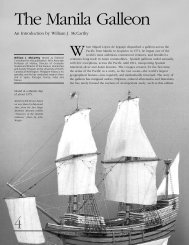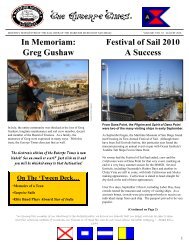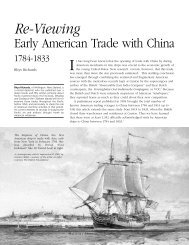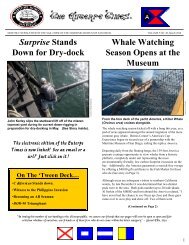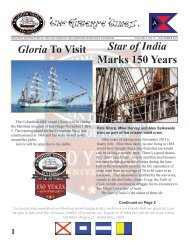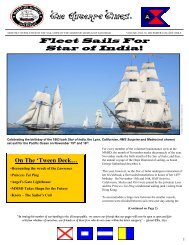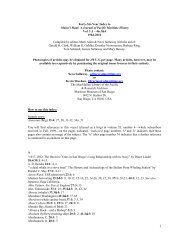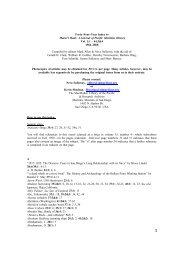Euterpe Times V3 NO. 42 - Maritime Museum of San Diego
Euterpe Times V3 NO. 42 - Maritime Museum of San Diego
Euterpe Times V3 NO. 42 - Maritime Museum of San Diego
Create successful ePaper yourself
Turn your PDF publications into a flip-book with our unique Google optimized e-Paper software.
Marine Steam (cont)<br />
was used in the American cruiser Olympia, built six years before<br />
the Berkeley, also at the Union Iron Works in <strong>San</strong> Francisco.<br />
Compared to the Berkeley’s single engine <strong>of</strong> 1163 horsepower,<br />
the Olympia had two engines <strong>of</strong> almost 9,000 horsepower each<br />
(6,750 designed). The triple-expansion engine worked best at<br />
pressures <strong>of</strong> 155-185 psia, so that the Berkeley was at the upper<br />
range <strong>of</strong> desirable steam pressures for the triple-expansion<br />
design.<br />
The next logical step was to divide the steam cycle among four<br />
cylinders, the quadruple-expansion engine. This design used<br />
steam pressures <strong>of</strong> 240 psia or higher, and was the final<br />
development <strong>of</strong> marine reciprocating steam engines.<br />
The next step was the turbine engine, which could use much<br />
higher steam pressures and temperatures. The standard USN<br />
steam plant <strong>of</strong> WW II used steam at 600 psia and 850 °F.<br />
Further Reading<br />
Diagram <strong>of</strong> the Watt Steam Engine in its most basic<br />
form showing the improvement <strong>of</strong> the separate<br />
condenser, which was not found on the Newcomen<br />
steam engine.<br />
<strong>of</strong> the atmosphere, the engine was smaller and lighter than a<br />
condensing engine, and not much less economical. This is the<br />
engine that powers steam locomotives.<br />
10<br />
High-pressure steam required better materials and construction.<br />
Once these became available, it was possible to supply highpressure<br />
steam to condensing engines, thus saving steam by<br />
closing the steam valve with the piston near the start <strong>of</strong> its stroke<br />
and using the expansive power <strong>of</strong> the steam for the rest <strong>of</strong> the<br />
stroke. The higher the initial pressure and temperature, the<br />
earlier in the stroke the steam valve could be closed. A large,<br />
single-cylinder marine engine is shown in the first picture.<br />
With steam <strong>of</strong> higher pressure and temperature at the beginning<br />
John Elder, in 1854, divided the steam expansion into two<br />
cylinders, so that each cycled through a smaller range <strong>of</strong><br />
temperatures and pressures. This was called the compound<br />
engine, as used in the Medea, and was suitable for steam<br />
pressures <strong>of</strong> about 100 psia. The compound engine was<br />
sufficiently economical to enable steamships to sail almost<br />
anywhere in the world.<br />
Improvements in materials and designs, even in lubrication,<br />
allowed still higher pressures and temperatures, and this allowed<br />
a further division <strong>of</strong> the steam cycle into three cylinders, the<br />
triple-expansion engine. The British Navy used the first tripleexpansion<br />
engine, in a cruiser in 1887, and that type <strong>of</strong> engine<br />
Pacific Time Machines:<br />
Recent Replicas & New Traditional Vessels<br />
Modern versions <strong>of</strong> old wooden ships, boats, and canoes have<br />
blossomed around the world in the past half-century. Pacific<br />
Time Machines is a wide-ranging survey <strong>of</strong> articles about many<br />
<strong>of</strong> those in the Pacific, from 1913 to 2005—each written by the<br />
designer or another involved in the project. Subjects range from<br />
HMS Rose and its re-creation as HMS Surprise for the movie<br />
“Master and Commander,” to the schooners Californian and<br />
Lynx, to Hawaiian voyaging canoes, feluccas, Chinese junks,<br />
and Chumash Indian board canoes. Authors include renowned<br />
naval architects Melbourne Smith and Phil Bolger, and Hawaiian<br />
canoe navigator Nainoa Thompson.



